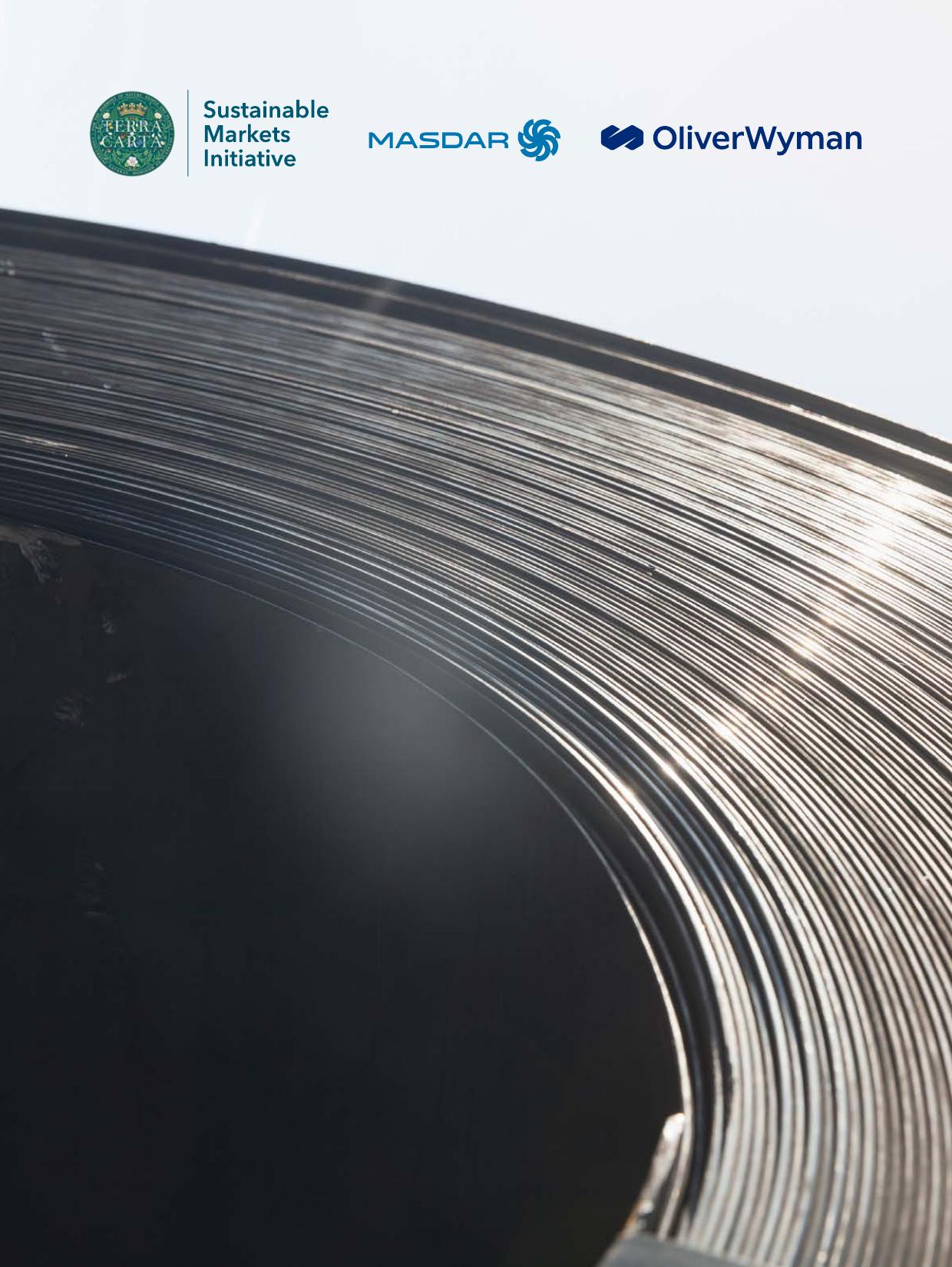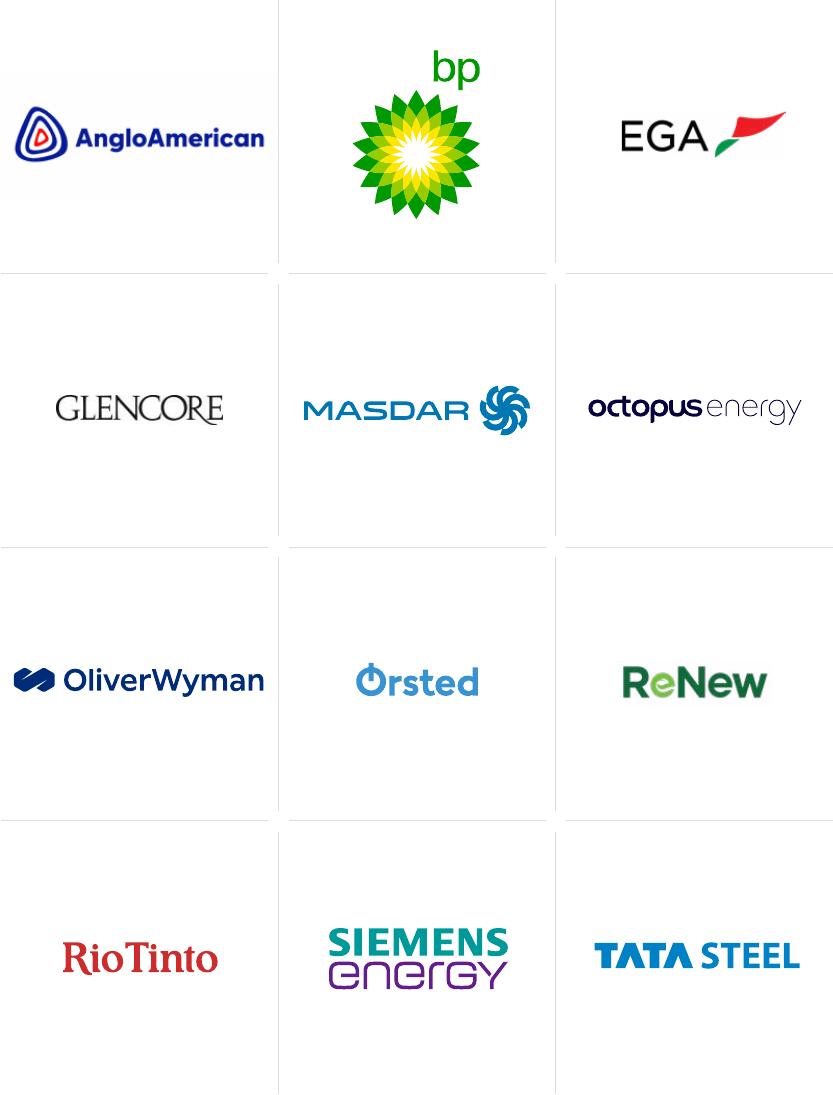ThedrivetodecarboniseindustryAhow-toguideforcompaniesNovember2023AcknowledgementsSustainableMarketsInitiativeFoundedbyHisMajestyKingCharlesIIIin2020,asPrinceofWales,theSustainableMarketsInitiativehasbecometheworld’s“go-to”privatesectororganisationontransition.Launchedin2021,theTerraCartaservesastheSustainableMarketsInitiative’smandatewithafocusonacceleratingpositiveresultsforNature,peopleandplanetthroughrealeconomyaction.EnergyTransitionTaskForceByinvitation,executivesfromsomeoftheworld’slargestandmostinfluentialindustrial,energy,andfinancialcompanieshavecometogethertoformtheEnergyTransitionTaskForce.Thistaskforceischargedwithdetermininghowcompaniesfromacrosstheenergyvaluechain,individuallyandcollectively,canplayaleadingroleindrivingandacceleratingthetransitiontoasustainablefuture.TheDecarbonisingIndustryWorkingGroupisoneofmultipleEnergyTransitionTaskForceworkinggroupsthatserveasacollaborativeplatformformembercompaniestoidentifyanddevelopcarbonemissionabatementsolutions.TheDecarbonisingIndustryWorkingGroupisfocusedonthreeofthehardest-to-abateindustries—steel,aluminium,andmining.Besidescompaniesfromtheseindustries,theworkinggroupalsoincludesselectedenergyandtechnologycompaniesthatareinterestedinsupportingcarbonemissionsabatementeffortsintheseindustries.Intotal,thereare11membersintheworkinggroup:MiningcompaniesAngloAmericanandRioTinto,aluminiumproducerEmiratesGlobalAluminium(EGA),steelmakerTataSteel,metalsproducerandtraderGlencore,renewableenergyproducersMasdar,Orsted,OctopusEnergy,andReNew,technologycompanySiemensEnergy,andglobalenergycorporationbp.OliverWymansupportedMasdarinleadingthisworkinggroup.WorkinggroupmembersMasdarCEOIntroductionMohamedJameelAlRamahi,ChiefExecutiveOfficer,MasdarAstheenergytransitioncontinuestogaintraction,therestillremainsanumberofobstaclespreventingitfromaccelerating,somethingthatweknowisneededinordertocontainglobalemissionsto1.5degreesCelsiusinlinewiththegoalsoftheParisAgreement.Oneofthoseobstaclesisthedecarbonisationofcriticalhard-to-abatesectorssuchassteel,aluminium,andmining.Altogether,thesesectorscontributeapproximately12%ofglobalcarbondioxideemissions,representingatremendousopportunitytosignificantlydrivedownemissions.1,2Withthatgoalinmind,Masdar,aglobalcleanenergypioneer,isproudtobeleadingtheDecarbonisingIndustryWorkingGroupaspartoftheSustainableMarketsInitiative’sEnergyTransitionTaskForce.Afterbringingtogetherleadingcompaniesfromacrosstheenergyandhard-to-abatesectors,theDecarbonisingIndustryWorkingGroupisnowreadytolaunchourfirstdeliverable“How-toGuide,”focusedonexploringtangiblesolutionsfordecarbonisation.Iamthankfultocolleaguesfromacrosstheworkinggroupforsharinginsightsandseekingmeaningfulcollaborationopportunities,theSustainableMarketsInitiativeleadershipforbringingustogether,andOliverWymanfortheirsupport.Thisworkdemonstratesthepotentialthatrenewableenergy,energyefficiency,carboncapture,greenhydrogen,andothersolutionscanofferingreeningindustriesacrosstheirvaluechains.Andithighlightstheobstacleswestillneedtoovercometogetthere.Onethingisclear:Thedecarbonisationjourneycanonlybesuccessfulthroughpartnership.ThisiswhatmakestheroleoftheSustainableMarketsInitiativesoimportant.AsweprepareforCOP28intheUnitedArabEmirates,wheredevelopingactionablesolutionstoensuretheworldmeetsitsclimatecommitmentswillbefrontandcentre,thisguideoffersatimelyandinformativeviewfromindustryleadersonhowwecanovercomewhatis,inmanyways,oneofthe“finalfrontiers”ofclimatechange:Decarbonisinghard-to-abatesectors.OliverWymanCEOIntroductionNickStuder,ChiefExecutiveOfficer,OliverWymanandInterimChair,SustainableMarketsInitiative’sEnergyTransitionTaskForceSteel,aluminium,andminingcontributedirectlytoaround12%ofglobalcarbondioxideemissions.3Businessleadersinthesecarbon-intenseindustriesarefacedwithaonce-in-a-generationopportunitytoinnovateandcollectivelyshapethetransitiontoamoresustainablefuture.TheDecarbonisingIndustryWorkingGroupwithintheSustainableMarketsInitiativebringstogethermarketleadersintheenergy,steel,aluminium,mining,andtechnologysectorstoworktogethertoacceleratethetransitiontonetzeroacrosshard-to-abateindustries.Thepremiseofthisgroupisthatorganisationswillmakegreaterandmoreefficientstridestowardssustainabilitythroughcollaborativeeffortsthanbypursuinginitiativesalone.Thesehard-to-abateindustriesfacenumerouschallengestodecarbonise,includingsecuringaccesstorenewableenergyandgreenhydrogenataffordablescale,navigatinganevolvingglobalmarketplace,andbeingabletorelyonasufficientandconsistentregulatoryframeworktoenactchange.During2023,theworkinggrouphassoughttoovercomethosechallengesbyidentifyingopportunitiestodecarbonisethesteel,aluminium,andminingindustries.Throughopendiscourseandsharingexpertise,severaldecarbonisationtopicshavebeenidentifiedthathavethepotentialtoreducecarbonemissionsmateriallyineachofthethreesectors.Afterfurtherexplorationandtesting,thegroupintendstodeveloppilotsthatcouldtransformtheirownoperationsandinspiretheirsectorstowardsswifterprogress.TosucceedinaforumliketheSustainableMarketsInitiative,allindustryparticipantsmustensurestrategicalignmentwithcounterparties,bringthefullforceoftheirorganisationtothetable,engagewithtrustandopenness,avoidwastingenergyonduplicativeinitiatives,andbringinotherentitieswherepartnershipsprovideafasterpaceofexecution.AtOliverWyman,weareproudtosupportthis“How-toGuide”andtheworkoftheSustainableMarketsInitiative,whichwebelievewillbehelpfulindeliveringdecarbonisationacrossindustrialsectors.Contents1.Executivesummary12.TheDecarbonisingIndustryWorkingGroup33.Carbonabatementchallengesandopportunities53.1.Steel83.2.Aluminium163.3.Mining234.Prioritisingaction305.Acallforaction37Acronymtable41Tableoffigures42Endnotes431.ExecutivesummaryAspartoftheSustainableMarketsInitiative'sEnergyTransitionTaskForce,itsDecarbonisingIndustryWorkingGroupwascreatedtofocusonthedecarbonisationneedsofthreeindustries—aluminium,steel,andmining.Itsmembershipincludes11companiesspanningtheenergy,steel,aluminium,mining,andtechnologysectors,withacollectivemissiontoidentify,develop,andundertakepotentialemissionsabatementpilotprojectsandstudieswithinthethreedesignatedhard-to-abateindustries.Together,thegroupdevelopedamutualunderstandingofpriorityregions,valuechainsteps,andactivitiesfordecarbonisationwithinthethreesectors.Themostpromisingandrelevantabatementsolutionswerethenreviewedinexpertinterviewsandworkshopsandassessedbasedontheirpotentialtoproducesignificantreductions,givenfactorssuchastechnologicalmaturityandscalability.Theoutcomewasaseriesofcollaborationtopicsthataddresscriticalsustainabilitychallengeswithintherespectivesectors.Thesetopics,whichareoutlinedinthisdocument,havethepotentialtobefurtherdevelopedintopilotprojectsthataccomplishkeydecarbonisationmilestones.Enablingandacceleratingdecarbonisationrequiresenhancedcollaborationandactionbetweenmultiplestakeholders:Governments,financialinstitutions,investors,thetargetindustriesandenterprisesthatsupporttheiroperations,technologydevelopers,andcustomers.1.Globalframeworksforregulationandpolicyonemissionsabatementmustbedevelopedtoensurealevelplayingfieldacrossregionsandindustries.Morealignmentoncarbonaccountingpracticesacrossindustriesandcountriesisneeded.2.Demandforgreenproductsispickingupbutneedstobesupportedwithpoliciesandincentives.Policymakersneedtoimplementincentivesandregulationsthatencouragesustainableprocurementpracticesacrossindustriesandcountries.13.Energyinfrastructureandcapacitiesneedtobescaleduprapidly.Policymakersneedtoensuresubsidies,incentives,andregulatoryframeworksinplacearesupportiveofsuchanambition.4.Transformationalinvestmentsareneededtomovetowardslow-carbonpracticesatscale.Policymakersmustestablishfundingprograms,grants,subsidies,andlow-interestloansspecificallytargetedatsupportingtheadoptionoflow-carbonsolutionsacrosssectors.5.Morefundingofresearchanddevelopmentisneeded.Governmentscansupporttheadoptionandadvancementoflow-carbontechnologiesbyfurtherincreasingthefundingandincentivesforgreentechnology-relatedresearch,patents,andpiloting.Thesimplebottomline:Thepaceoftransformationinhard-to-abateindustriesneedstoacceleratetocomplywiththe2015ParisAgreement’stargetofnetzeroby2050tokeeptheplanet’stemperatureincreasetoaround1.5degreesCelsius.Heavyindustryfacesauniquechallengeasdemandforitsproducts—manyfundamentaltotheglobalgreentransformation—continuestorise.PlatformsliketheSustainableMarketsInitiativeareworkingtoprovidethestrategiesandtechnologiestoaccelerateindustrialprogress,eveninhard-to-abatesectors.Theaimofthisguideistoprovidearoadmapforallindustriesandcompaniesonhowtostepuptothedecarbonisationchallengeandprovidesufficientresourcestobuildtowardsamoresustainablefuture.22.TheDecarbonisingIndustryWorkingGroup3GroupobjectivesAspartoftheEnergyTransitionTaskForce,theDecarbonisingIndustryWorkingGroup’sobjectiveistoaccelerateemissionsreductioneffortsandprovidestrategicbreakthroughsforhard-to-abateindustries.Achievingnet-zerotargetsinsteel,aluminium,andminingrequiressignificantprocessandbusinessmodeltransformations,andthisworkinggroupaimstodrivethiseffortbycultivatingcollaborationamongkeyindustrial,energy,finance,andtechnologyplayers.Thisworkinggroupsetouttodeterminefeasiblealternativetechnologies,processes,andrawmaterialsthatwouldacceleratedecarbonisationpathwaysandidentifycollaborativeinitiativesandstudiesthatmightfosterfasterdecarbonisationthroughpotentialpilotprojects.Theguideisintendedtoserveasausefulresourceforstakeholdersinhard-to-abateindustries.Itprovidesdetailsontheemissionsprofiles,technical,andgeographicalchallenges,keyabatementpathways,andpressingtopicsforeachofthethreeprofiledindustries.Italsodemonstratesanapproachtocross-companycollaborationforleaderswithsimilarambitionstofollowandcaptureslessonslearnedfromearlierefforts.Additionally,theguidehighlightstheneedformultiplestakeholderstogetinvolvedindecarbonisationdiscussionstoaccelerateinnovationandpartnerships.Collaborationiscrucialforachievingthenecessarytransformation,andtheguideemphasisesthatnosinglecompanycanachievethistransformationalone.Theworkinggroupplanstocontinuethisengagementafterthereleaseofthisguidewiththegoalofdevelopingthecollaborationagreementsfurtherandconductingfeasibilityandpilotstudies.43.Carbonabatementchallengesandopportunities5Steel,aluminium,andminingcollectivelycontributetoaround12%ofglobalcarbondioxideemissions.4,5TheseindustrieswerespecificallyprioritisedbytheSustainableMarketsInitiativebecauseoftheirpotentialtosignificantlyreduceglobalemissions,theirimportancetotheglobaleconomy,andtherelativedifficultyofcurbingthecarbonintensityoftheiroperationsandprocesses.Thissectionoutlinestheemissionabatementchallengesandopportunitiesineachindustryandshowswhytheyareconsideredhardtoabate.Exhibit1:Directglobalcarbondioxideemissionsin2022InpercentageofglobalcarbondioxideemissionsSteelMining8%2%Aluminium2%Globalcarbondioxideemissions36.8GtNote:Minedmaterialsinscopeincludecoal,copperore,usableironore,nickel,zinc,andbauxiteandfiguresexcludefugitivemethaneemissions.Sources:IEA(2023),NetZeroRoadmap:AGlobalPathwaytoKeepthe1.5°CGoalinReach,IEA,ParisLicense:CCBY4.0,OliverWymananalysis6DeepDiveThebiggestemissionschallengesWhatmakesthesteel,aluminium,andminingindustrieshardtoabate?Sevenprevalenteconomic,regulatory,andtechnicalthemesacrossthethreesectorsunderscorethemagnitudeofthechallengeincurtailingcarbonemissions.1TheinherentcarbonintensityoftheprocessesKeyprocessesandactivitiesinhard-to-abateindustriesoftenentailcarbondioxidegenerationthroughessentialchemicalreactionsandhigh-temperatureoperationsthatdemandsubstantialenergyinput,necessitatingtransformationaltechnologytoaddressthemeffectively.2IncreasingproductionvolumesalongwitheconomicgrowthTheindustriesinscopearefoundationalforeconomicgrowthanddevelopment—whetheritinvolvesconsumerssuchasconstruction,automotive,energyinfrastructure,orconsumergoods.Withfutureeconomicgrowthandincreaseddemandofthesebuilding-blockcomponentsfortheenergytransition,productionvolumesandsubsequentcarbonemissionswillonlyincreaseifnothingchanges.3LackofeasyalternativesAlthoughlow-carbonalternativesmayexist,thesesustainabletechnologiesmaynothavereachedcommercialscaleorarenotyetcostcompetitiveinaglobalmarketplacemakingswiftdecarbonisationacrosshard-to-abateindustriesdifficult.4RelianceonotherindustriestodecarboniseHard-to-abateindustriescannotdecarbonisealone.Toeliminateemissionsfromoperations,theydependontheavailabilityofreliableandscalablerenewablepower,supportinginfrastructuresuchasthegridandenergystorage,andaccesstocriticalinputmaterialssuchasgreenhydrogenandhigh-qualityironore.5LonginvestmentcyclesandhighinvestmentrequirementsThecomplexity,scale,andglobalinterdependenceofhard-to-abateindustriesleadstolargeupfrontcapitalinvestment.Companiesarereluctanttoaltertheirtechnologiesandinfrastructurebeforetheyhaverealisedreturnsontheirpastinvestmentsunlesstheyareconfidentitwillresultinsignificantemissionsreduction,costsavings,orhigherpricesforgreenproducts.6CompetitivedynamicsHard-to-abateindustriesrequireclearmarketdemandsignalsforgreenproductstoinforminvestmentdecisions.However,theseindustriestodayarelackingthenecessaryofftakeagreementsfromcustomersforgreenproducts,especiallythosethatcomeatapremium.7RegulatoryuncertaintyHard-to-abateindustrieswillrelyongovernmentsintheshort-tomedium-termtomaketheirnetzerotransitionpossible.Negativesentimentaroundregulatoryuncertaintyputsexistingorpotentialsustainableinvestmentsatrisk,especiallyifcompaniesarecompetinginaglobalmarketplacewithanunevenplayingfield.73.1.SteelKeyfigures1.9billion~8%>2tonnestonnesofglobalcarbondioxideofcarbondioxideproducedofprimaryandsecondaryemissionsattributabletopertonneofsteelsteelproducedannuallysteelproductionKeytechnicalchallengesAccesstogreenhydrogenReducingemissionsfromImprovingscraprecycling,andrenewablepowerforblastfurnacesinthecollecting,andsortingcrudeandsecondarymedium-terminfrastructuresteelproductionSteel’sdirectcarbonfootprint(Scope1and2)comprisesaround8%ofglobalcarbondioxideemissions,andforeachtonneofsteelproduced,nearlytwotonnesofcarbondioxide(CO2)areemittedonaverage.6Overthelastfewyears,justundertwobillionmetrictonnesofsteelhavebeenproducedannually—withemergingmarketsleadingthegrowthindemand.7Theseprojectionsunderscoretheneedforgreatereffortsbytheindustrytoadoptsustainablepracticesandminimisesteel’senvironmentalimpact,givenitscurrentemissions-intensiveprofile.Exhibit2:GlobalsteeldemandgrowthbyregionInbilliontonnes1.92.02.01.90.11.91.80.10.10.10.10.10.10.10.20.20.10.10.20.20.20.40.50.40.40.40.91.01.11.01.0201820192020202120222030SouthAmericaNorthAmericaMiddleEastandAfricaEuropeChinaAsiaPacificAfricaWorldforecast2030Sources:WorldSteelAssociation(2022),Totalproductionofcrudesteel,Worldtotal2022,OliverWymananalysis8CarbondioxideemissionsprofileBlastfurnace—basicoxygenfurnaceThesteelproductionindustryprimarilyfollowsthreesteelproductionpathways,withthemostprevalentbeingtheblastfurnace-basicoxygenfurnace(BF-BOF)route,accountingfor63%ofglobalsteelproductioncapacityandemitting2.2tonnesofcarbondioxidepertonneofsteelproducedonaverage.8TheprimaryenergyinputfortheBF-BOFprocessiscokingcoal,whichisusedtogeneratetheheatinsideoftheblastfurnaceandchemicallyreactwiththeironore.Cokingcoal,asapureformofcarbon,isusedratherthanregularcoalbecauseofitsstrengthwhichisneededinablastfurnaceoperationaswellasitshighcarboncontentwhichaidsinthereductionoftheironore.Theprocessofmakingcokingcoal,whichinvolvesbakingcoalinanovenfor12to36hoursatalmost1,100degreesCelsius,alsoproducesemissions.Thisprocessreducesimpurities,butitalsocreatesCO2andmethane,anothergreenhousegaswithasmuchas80timesthewarmingpotentialofCO2over20years.AdditionalCO2emissionsarereleasedwhenpureoxygenisinjectedintothebasicoxygenfurnacetoconvertthepigironintosteelbyreducingitscarboncontent.Scrap-basedelectricarcfurnaceScrap-basedelectricarcfurnaces(EAF)arethesecondmostprevalentsteelproductionmethod.InanEAFwhereheatisgeneratedfromanelectricarcbetweentwographiteelectrodeswhichmeltsthescrapsteelandironore.Thegraphitealsoactsasareducingagent,whichliberatestheoxygenatomsfromtheironore.AverageemissionsfromelectricarcfurnacesareconsiderablylowerthantheBF-BOFrouteat0.4tonnesofCO2pertonneofsteel(tCO2/tofsteel)asseeninthechartbelowsincetherecycledscrapjustneedstoberemeltedandpurified.9Pertonneemissionsfromelectricarcfurnacescanreachaslowas0.1tCO2/tofsteelifpoweredbyrenewableenergy;however,EAF’stypicallyrelyheavilyonon-sitepowergenerationandlocalelectricitygrids.Dependingontheenergymixofthepowergeneration,carbonemissionsfromthesesourcescanbesignificant.Directreducediron—electricarcfurnaceandelectricsmeltingfurnaceProcessesusingdirectreducediron(DRI)accountforsevenpercentofglobalsteelcapacity.10TheDRIprocessreduceshighqualityironorepelletsdirectlyinsolidformatlowertemperaturestoproducehotbriquettediron(HBI)withouttheneedforblastfurnacesandcokingcoal.DependingontheHBIquality,thematerialistransferredtoanEAForelectricsmeltingfurnaceformeltingandsteelproduction.9IftheDRIshaftutilisesgreenhydrogen,emissionsfromtheproductionoftheironcanbenearzero.However,mostofDRIfacilitiesinusetodayarepoweredbynaturalgasorcoal,whichemitCO2throughthereductionoftheDRironoregradeintheshaftfurnace.TotalemissionsfromDRI-basedprocessescanrangefrom1.3tonnesofCO2pertonneofsteelproducedwhenusingnaturalgastoover2.5tonnesofCO2inthecaseofcoal-basedDRI.11Exhibit3:PrincipalsteelproductionpathwaysIronmakingSteelmakingProcessingPre-processing0.2ScrapO0.2~0.21.2CoalCokeplantCokeBF-BOF0.2<0.12.2tonnesofCO2pertonneofsteelBlastfurnacePigironBOFCrudesteelElectricityprocessingIronoreSinterplantPelletplantIronsinterpellets0.2~0.2EAF0.4tonnesofCO2Scrap-basedpertonneofsteelScrapEAFCrudesteelprocessingNaturalgas0.2<0.10.60.2~0.2DRI->67%SinterplantPelletplantIronsinterShaftfurnaceHBIEAF/ESFCrudesteel1.3EAF/ESFprocessingtonnesofCO2withnaturalgaspertonneofsteelIronorepelletsNotes:EAF,sintering,pelletising,andcrudesteelprocessingemissionsdependontheenergymixoftheelectricitysupply,estimatesbasedonglobalaverages,totalemissionsperproductionroutemaydifferfromsumshownbecauseofrounding.Sources:EuropeanCommission(2022),TechnologiestodecarbonisetheEUsteelindustry,OliverWymananalysis10GeographicdiversityTheconflictingchallengesoffulfillingrisingglobaldemandandreducingemissionsarefurtherexacerbatedbythediversityofsteelmakingtechniquesandlandscapesaroundtheworld.Eachregion’suniqueassetmix,energyinputs,productionfeedstocks,andregulatoryenvironmentnecessitatesatailoredsteeldecarbonisationpathway.Aregion’sshareofsecondarysteelmakingthroughEAFandtheageofexistingBF-BOFassetssetabaselineforemissionsreductiontargetsandpathways.GiventhesignificantdecreaseinemissionspertonneofsteelproducedviaEAF,regionswithhighersharesofsecondaryproductionoftenfarefarbetterintermsofaveragecarbonintensity.However,EAFsdependontheavailabilityandpricingofscrapsteeltooperate,andregionswithhistoricallylowsteelusageand/orproductionfaceafurtherdecarbonisationchallengebecauseofthelowscrapsupplyandhighimportcosts.Exhibit4:Regionaloverviewofsteelproductionmix2023InpercentageoftotalproductionSources:GlobalEnergyMonitor(2023),CountofIron&SteelPlantsbyProductionMethodinEachCountry,OliverWymananalysisTheageofsteelproductionassetsalsoaffectsdecarbonisationpathwaysandinvestments.Steelproductionassetstypicallyhavealifespanoverfourdecades,andyoungersteelmarketsarelesslikelytomovetowardslow-carbontechnologiesbecauseoftheneedtorealiseareturnontheinfrastructureinvestment.Strategiesfordecarbonisingyounger,emissions-heavyassetsmayincludeacombinationoffuelswitching,retrofittingexistingsteelplants,anddecommissioningorincentivisingtheswitchthroughforeignaidorinvestmenttocompensateforlostreturnoninvestment(ROI).11Achievingadecarbonisedsteelindustryiskeyforasustainablefutureandreachingnetzero.Itrequiresthediverseanduniqueconstraintspresentineachregiontobeunderstoodandaddressedthroughindustrycommitmentandgovernmentpoliciessuchastaxcredits,ordecarbonisationsubsidies.Exhibit5:Primaryemissionsfromsteelmakingbyregionin2022InmilliontonnesofcarbondioxideChina1002501,600NorthAmericaEurope55050130AsiaPacificexcludingChinaSouthAmericaMiddleEastandAfricaNote:Bubblesizesindicative.Sources:IEA(2020),IronandSteelTechnologyRoadmap,IEA,ParisLicense:CCBY4.0,WorldSteelAssociation(2022),Totalproductionofcrudesteel,OliverWymananalysisAbatementpathwaysandchallengesThedecarbonisationofsteelmakingprincipallyreliesontwopathways:Decarbonisingcrudesteelproductionandreducingcarbondioxideemissionsfromsecondarysteelproduction.DecarbonisingcrudesteelproductionToaddressthedemandforcrudesteel,hydrogen-poweredDRItechnologypresentsadecarbonisationopportunity.DRIprocesseshaveseveralinherentsustainabilityadvantagesovercarbon-basedblastfurnaces.First,theycanberetrofittedtoutilisebothnaturalgasandhydrogenastheironorereducingagent—bothofwhichemitlesscarbonthantheintegratedsteelmakingrouteandcoal-basedDRI.Second,thehotbriquettedironproducedcanbefeddirectlyintoexistingdownstreaminfrastructurereducingtheneedforfurtherinvestment.Usinggreenhydrogen—producedthroughelectrolysiswithrenewableenergy—istheoptimalsolutionbecauseitreleasesalmostnoemissions.12IncreasingdemandsignalsforgreensteelproducersThroughadetailedlifecycleemissionsassessmentofoffshorewindfarms,OrstedidentifiedsteelprocurementasamajorsourceofScope3emissions.ThroughapartnershipwithDillinger,low-carbonsteelproducedviaaDRI-EAFfacilitywillbeusedforoffshorewindturbinefoundations,reducingemissionsfromsteelprocurementbyover50%.Offtakeagreementssuchasthisprovidethesteelindustrywiththedemandandpricesignalsneededtojustifytherequiredinvestmentsinlow-carbonsteelproduction.8Therearechallengesassociatedwiththewidespreadadoptionofhydrogen-poweredDRI.Sincetheironoreisreducedinitssolidstate,theironoreinputqualitystandardsforDRIaretypicallyhigherthanthatoftraditionalblastfurnaces;only13%ofironoreexportstodayaresuitableforfeedingintoDRIshaftfurnaces.12Giventheprojectedsteelproductionoriginatingfromtheseprocesses,theindustrywillneedtoinvestinupstreambeneficiationtechnologyforlowergradeironoresandsubsequentdownstreamprocessestoallowtheoutputtedhotbriquettedirontobeutilisedinanelectricarcfurnace.ForDRItechnologytocreateasignificantimpactonsteelemissions,theindustrymustaddressthreekeyhydrogen-relatedissues:Buildingoutthehydrogensupplychain(includinggeneration,transport,andstorage),growingthecurrentinadequatesupplyofrenewableenergyrequiredforgreenhydrogenproduction,andnavigatingthedemandandpricecompetitionforhydrogenfromotherheavyindustries(forexample,chemicals).Addressingthechallengesofgreenhydrogenandironoresupplywillbecrucialforthesuccessfullarge-scaleintegrationandglobaladoptionofDRIandEAFtechnologies.Itwillrequiredifferentindustriesworkingtogethertocoordinateeffortsandraisethecapitalinvestmentrequired.SteelmakerscanalsocaptureCO2fromblastfurnacesortheirdownstreamoperationsandeitherstoreorutilisethegastocreatevalue-addedproducts,suchasmethanol,biogas,orsustainableaviationfuel.Suchmethodsarecriticalforshort-ormedium-termsolutions.13ReducingcarbondioxideemissionsfromsecondarysteelTheEAFshareofsteelproductionisexpectedtoincreaseasthescrapmarketexpandsglobally.IntheEuropeanUnion(EU),theEAFshareisexpectedtogrowfrom40%todayto80%in2040.13Ifpoweredbyrenewableenergy,thecarbondioxideemissionsfromthemeltingofscrapsteelinanEAFarenearzeroandcanbecoupledwithelectrifiedupstreamanddownstreamprocesses,suchasscraphandlingandsteelprocessing,toproducenear-zerogreensteel.However,theexpansionofEAFtechnologywillbeconstrainedbyhighscrappricescoupledwithlimitedsupplyandbyinadequateaccesstorenewableenergyandstoragetoreliablypowerazero-emissionselectricarcfurnace.Forexample,by2030,producing32milliontonnesofflatgreensteelinEuropewouldconsume12%oftherenewableenergyavailableintheregion,whilestillonlysatisfyingabout30%ofdemand.Additionally,thequalityofsteelproducedfromthisprocessisalsolimitedbythequalityofthescrapfeedstock.TosupportEAFproduction,thesteelindustrymustincreasetheiraccesstorenewableenergyanddevelopgreatercapabilitiesforscrapcollecting,handling,andsorting.Industriescurrentlyreliantonbyproductsfromprimaryandsecondarysteelmakingwillalsofacethechallengeofadaptingtheirprocessesandsupplychainstoaccountforthereducedavailabilityofrawmaterials.Forinstance,slagcreatedinblastfurnacesservesasacrucialrawmaterialinputforPortlandCementproducersbecauseofitscost-effectivenessandrobustmaterialproperties,makingitanidealfeedstockforlarge-scaleconstructionprojects.Toscaleupgreensteelproduction,manysteelproducersarealsoplanningtophaseouttheirblastfurnacefleetbycombiningscrap-basedelectricarcfurnacesandDRI-basedprocesses.14Exhibit6:Carbondioxideemissionsfromcurrentandfuturelow-carbonsteelproductionIntonnesofcarbondioxidepertonneofcrudesteelSource:MissionPossiblePartnership(2022),MakingNet-ZeroSteelPossible.KeyTakeaways1.Decarbonisationofprimarysteelmakingwillrelyonthebuildoutofhydrogeninfrastructureincludingtherenewableelectricityrequiredforhydrogengeneration.2.Inorderforhydrogen-poweredDRItotransformtheindustry,steelmakersandminingcompaniesmustinnovatearoundtheshortageofDRgradeironoreandinvestinenhancedupstreambeneficiationanddownstreamprocessingtomakelowergradeoressuitableforuse.3.Carboncapturewillplayacrucialroleindecarbonisingsteelmakingsincemanytraditionalintegratedsteelmillsaroundtheglobestillhavelongusefullifespansandresidualemissionswillexistformostlow-carbonsteelmakingroutes.4.Policymakersmustworktoevenouttheplayingfieldforlow-carbonsteelmakerstocompeteinaglobalmarketplacewithdifferentlevelsofsupportrequiredbyregion.5.Customersofthesteelindustrymustgrantlong-termofftakeagreementswithcleardemandandpricesignalstolow-carbonsteelproducerstode-riskfutureinfrastructureinvestments.Intheabsenceofcleargreenpremiumsandvolumes,strictergovernmentalregulation,andanincreasedcarbontaxwillhavetofillinthegap.©OliverWyman153.2.AluminiumKeyfigures>65million~2%>16tonnestonnesofglobalcarbondioxideofcarbondioxideproducedofprimaryandsecondaryemissionsattributabletopertonneofprimaryaluminiumproducedaluminiumproductionaluminiumannuallyKeytechnicalchallengesReliable,cost-effectiveElectrifyingaluminarefiningDevelopingcommercialrenewableenergyforprocessesinconjunctionscaleinertanodeslocationswithoutwithrenewableenergyhydropowerAluminiumproductionemitsanaverageofover16tonnesofcarbondioxideemittedpertonneofprimaryaluminium.Thus,thealuminiumindustry’sdirectcontributiontoannualcarbondioxideemissionsisabouttwopercent.14Bytonnage,aluminiumisthesecondlargestmanufacturedmetal,withitsprimaryconsumersinthetransportandconstructionindustrieswhichaccountforabouthalfoftotaldemand,andglobaldemandisexpectedtoincreasefurtheroverthecomingdecadesasstandardsoflivingrisearoundtheworld.Asizeableportionoftheanticipatedgrowthisexpectedtobedrivenbydemandforthematerialsrequiredfortheindustrytransition,suchassolarphotovoltaic(PV)panels.Furthermore,aluminium’slightweightandrobustpropertiesmakeitacrucialenablerforothersectorssuchasaviationtoreducetheircarbonfootprints.Exhibit7:GlobalaluminiumconsumptionInmilliontonnes78.862.561.963.365.266.636.535.837.338.840.47.87.67.57.57.020307.37.47.57.77.06.36.16.46.46.33.84.03.93.73.81.11.01.21.31.220192020202120222018SouthAmericaNorthAmericaAsiaexcludingChinaMiddleEastandAfricaEuropeChina2030WorldforecastSources:InternationalAluminium(2022),PrimaryAluminiumProduction,OliverWymananalysis16CarbondioxideemissionsprofileAbout70%ofallaluminiumproductioninvolvestheprocessofrefiningbauxite,aluminium’sbaserawmaterial,intoaluminaandsmeltingthealuminaintoprimaryaluminium.15Secondaryaluminiumproductioninvolvestherecyclingofscrapaluminiumandremeltingittopurifythematerialforre-processing.AsshowninExhibit8,approximately85%oftheScope1and2emissionsgeneratedduringtheproductionofprimaryaluminiumcomefromtherefiningandsmeltingphases(includinganodeproduction).16BauxiteminingandaluminiumcastingcombinedaccountforafractionoftheScope1and2emissionsgeneratedduringtheproductionofprimaryaluminium.Exhibit8:Directandelectricity-relatedgreenhousegasemissionsofprimaryaluminiumproductionIntonnesofcarbondioxideequivalentpertonneofaluminiumproduced(tCO2Eq/tAl)<0.10.110.310.70.4<0.12.4Casting5.42.00.9SmeltingTotalAnodeproduction(primaryaluminium)RefiningScope1emissionsScope2emissionsNote:Scope1emissionsincludesCO2andperfluorocarbon(PFC)emissions;emissionscalculatedasfulllifecycle(cradle-to-gate)emissions.Sources:InternationalAluminium(2021),GreenhouseGasEmissionsIntensity-PrimaryAluminium,OliverWymananalysis17SmeltingThehighaveragecarbonintensityofaluminiumproductionprimarilystemsfromtheelectricitydemandofsmeltingalumina,generallybymeansoftheHall-Héroultprocess,accountingforover80%ofaluminiumproduction’sScope1and2emissions.17Infact,thecombinedelectricityconsumptionfromsmeltinggloballyisgreaterthanthetotalelectricityconsumptionofentirecountriessuchasBrazil,ortheUnitedKingdom.Oftheemissionsfromsmelting,around19%aredirectemissionsderivedfromtheuseofcarbon-basedanodes.Theproductionofthecarbonanodesneededforelectrolysisalonegenerates0.9tonnesofCO2pertonneofaluminium(tCO2/tAl)becauseoftheenergyrequiredtorefinecokingcoalintoanodes.Moreover,duringelectrolysis,significantCO2andperfluorocarbonemissionsarereleasedastheanodesreactwiththeoxygenatomsfreedfromthealumina.Onaverage,theScope1emissionsfromthesmeltingtotalsaround2.4tCO2/tAl.Thebulkofsmeltingemissionsareelectricity-relatedemissionsderivedfromtheenergygenerationneededtopowerthesmelters—theglobalpowermixsupplyingthesesmeltersremainsheavilyreliantonfossilfuels.In2022,55%ofthepowersuppliedtosmelterscamefromcoaland10%fromnaturalgas.18However,thedependenceonfossilfuelsisnotablyhigherinChina,Oceania,andtherestofAsia,whiletheAmericasandEuroperelymostlyonhydropower(seeExhibit9).Exhibit9:SmeltingpowermixbypowersourceInpercentageoftotalpowerNorthAmerica595SouthAmerica1682211Europe11393Africa5941GCC991Asia(excludingChina)946China82162Oceania581381Worldaverage5710312CoalOilNaturalgasNuclearHydroRenewableOthernon-renewableSources:InternationalAluminium(2022),PrimaryAluminiumSmeltingEnergyIntensity,OliverWymananalysis18RefiningInadditiontosmelting,therefiningprocessrequireshightemperaturesduringaluminahydratecalcinationandlargeamountsofhotsteamfortheBayerprocessandcalcinationwheresteamandheataretypicallygeneratedusingfossilfuels.Refiningbauxiteintoaluminareadyforsmeltingisthesecondmostemissions-intensivephaseofaluminiumproduction,accountingforapproximately15%oftheindustry’sScope1and2emissions.19Ofthe2.4tCO2/tAlemittedacrosstherefiningprocess,83%areScope1emissionsmadeupofthermalenergy,non-CO2emissionsandancillarymaterials.Theremaining17%ofemissionsfromtherefiningprocessesareScope2,withtheBayerprocessandcalcinationtypicallypoweredbyfossilfuels.InNorthAmerica,Europe,andtheMiddleEast,aluminarefiningreliesonnaturalgastogenerate95%to100%oftheenergyneeded,whileinAustralia,around60%isderivedfromgaswiththeremainderfromcoal.20GeographicdiversityThealuminiumindustrymustcontendwithuniquegeographicalconstraintsineachregion.Onesharedconcernistheemissionsfromelectricityconsumptionusedinprimaryaluminiumproductionwhereaccesstorenewableenergyresources,effectivestorage,andenergymanagementisvital.Thelocationofaluminiumproduction,andspecificallythesmelter’slocation,significantlyinfluencesthetotalgreenhousegasemissions.Forinstance,theemissionsfactoroftheSouthAfricanpowergrid,primarilycoal-powered,isaround20timeshigherthanNorwaywheremostpowerisgeneratedfromhydropower.21Also,sincesecondaryaluminiumhasasignificantlylowerenergyandcarbonintensitythanprimaryaluminium,regionswithaccesstorobustrecyclinginfrastructure,sortingfacilities,andlargescrapquantitiesfarefarbetterintermsofaveragecarbonintensityfromaluminiumproduction.ExpandingsecondaryaluminiumintheMiddleEastSecondaryaluminiumrequiresonlyfivepercentoftheenergyneededforprimaryaluminiumproduction.EGA,inpartnershipwithleadingwastemanagementcompanies,formedtheAluminiumRecyclingCoalitiontoembedrecyclingpracticesandinfrastructureintheMiddleEasteconomy.EGAisalsoplanningtobuildthelargestrecyclingfacilityintheUnitedArabEmirateswithacapacityofover150,000tonnesperannum.19Exhibit10:Primaryaluminiumproductioncarbondioxideemissionsbyregionin2022InmilliontonnesofcarbondioxideChina4501050NorthAmericaEurope106080SouthAmericaMiddleEastandAfricaAsiaPacificexcludingChinaNote:Bubblesizesindicative.Sources:InternationalAluminium(2022),PrimaryAluminiumProduction,OliverWymananalysisAbatementpathwaysandchallengesAluminiumisconsideredahard-to-abateindustrybecauseoftherelativetechnologicalimmaturityofthenecessarysolutionsandsubstantialfinancialcommitmentoftransitioningtodecarbonisedtechnology.Thelargeandconstantenergydemandofsmeltersisatoddswiththeintermittencyofrenewableenergy.Nonetheless,withacceleratedandsustainedefforts,decarbonisationispossible,andprogressisbeingmadeasmanyofthenecessarytechnologiesapproachcommercialmaturity.20SmeltingThegreatestopportunityforreducingaluminium’scarbondioxideemissionsrestswithrenewablepowergenerationasmorethan60%oftheindustry’scarbondioxideemissionsisaconsequenceofelectricityconsumption.Withone-thirdofthe200+worldwidesmeltersreliantongridpower,therateofdecarbonisationwillbemostlydeterminedbythespeedatwhichthegridtransitionstoamorerenewableenergymix.22However,theincreasingvariablerenewableenergyinlocalpowergridscancausetransmissioncongestion,limitingtheimpactthatrenewablescanhave.Tolimitgridcongestioninnetworks,regulatorsmustprovideinnovativeframeworkstoencouragethedirectintegrationofvariablerenewableenergyandheavyindustrywhichcancircumventcongestionatscaleandatpacewithlowersocietalcostfromtransmissioninfrastructureandreservereimbursement.PlacinginvestmentsinrenewableswheretheyareneededthemostThescaleofrenewableexpansionoverthenexttwodecadeswillbeunprecedented.Vastamountsofnewrenewablegenerationcapacitywillneedtocomeonlinetosupportheavyindustrydecarbonisationforhydrogenelectrolysers,aluminiumsmelters,electricarcfurnaces,andnewlyelectrifiedprocesses.TheDecarbonisingGridsWorkingGroup,alsowithinEnergyTransitionTaskForce,isseekingtoincreasegridcapacityandflexibilityinkeyAfricanmarketsbycombiningpublicandprivatefundingandbringingtherightstakeholderstogethertocreatearegulatoryandpolicyframeworktosupportexternalinvestment.Theincreasedprevalenceofrenewablepowerpurchaseagreementsofferssomebargainingleverageforquickeradoptionofrenewablepowerthroughthegrid,butthemarketremainsimmatureinseveralkeyregions.Inmanycountries,demandfaroutstripssupply.Fortheremainingtwo-thirdsoftheworld’ssmeltersthatuseproducer-generatedenergy,twoprincipalsolutionsareincreasedrenewablepowergeneration,includinghydroelectricpower,hydrogen,andotherrenewables,and/orincreaseduseofcarboncapture,utilisation,andstorage(CCUS)technologies.Alongsideincreasingrenewableenergyusage,thedevelopmentofinertanodetechnologyiscriticaltoachievingcarbon-freealuminium.InertanodeseliminatetheScope1emissionsbyreplacingthecarbonanodeswithanothermaterialthatcanremovetheoxygenatomsfromthealuminawithoutreleasingcarbondioxide.21RefiningPathwaystocutaluminarefining’sScope1and2emissionsrequireatransitiontorenewablepower,andelectrificationofrefiningprocesses.Sincemosttraditionalcalcinersarefossil-powered,theindustryrequiresanelectricorhydrogen-poweredcalcinertotakeadvantageoffossil-freeenergy.Also,thereareopportunitiesforheatrecaptureandprocessefficiencyintheBayerprocessthroughvarioustechnologies.Ifpreviouslywastedthermalenergyintheformofuncontaminatedsteamcanbereutilisedfromelectriccalcination,emissionsfrompowergenerationandsteamproductioncanbereduced.However,thesteamrequirementsfortheBayerprocesswillrequirefurtherenergyinput.Toproducetheadditionalsteam,processesmustbeadaptedtouserenewableenergy,suchascondensedsolarandphotovoltaic.KeyTakeaways1.Althoughadecarbonisedpowersupplyandincreasedsecondaryaluminiumarecriticaltoachievingnetzero,thealuminiumindustrywillrequireseveralotherdevelopingtechnologiestoworkintandemwitheachother.2.Customerandproducersrequireaclearerregulatoryframeworkforcarbonaccounting,carbonpricing,andsubsidiestoincentivisefurtherinvestmentsindecarbonisation.Regionalvariationsinaccesstorenewableenergyandtechnologicaldevelopmentmustbeconsidered.3.Accesstorenewableenergyandsecondaryaluminiumvarieswidelyacrosstheglobe;regulatorsmuststrikeacarefulbalancewhileincentivisinggreenproduction.4.Customersofthealuminiumindustryhaveacrucialroletoplayingivinglong-termofftakeagreementswithcleardemandandpricesignalstoproducerstoincentivisefutureinvestmentsinlow-carbonaluminium.223.3.MiningKeyfigures15.6billion<2%0.6billiontonnestonnesofglobalcarbondioxideofcarbondioxideproducedofkeymetalsandemissionsattributablebytheminingindustrymineralsminedperyeartominingactivities(Scope1,2)annuallyKeytechnicalchallengesFurtherdevelopingTransitiontorenewableDevelopinglow-carbonzero-carbonalternativesenergyandelectrificationshippingfuelsfortohaulageandtransportforprocessingseabornetransportThecoreminingactivity—extractingandmovingbillionsofmetrictonnesofmaterialandequipment—makesiteasytounderstandwhytheminingindustryisoneofthemajorcontributorsofemissions,accountingforlessthantwopercentofglobalcarbondioxideemissions(notincludingfugitiveemissions).Thisfigureonlyaccountsforextractionandbasicon-siteprocessingofthesixkeyminedcommodities(coal,copperore,ironore,nickel,bauxite,andzinc),withproduction,manufacturing,andenduseresultinginfurtherScope3emissions.Theseindirectemissionscanbeupto10timesgreaterthanthoseemittedattheminesiteandmustthereforebetargetedduringthedecarbonisationprocessoftheentirevaluechain.23Scope1and2carbondioxideemissionsacrosstheindustryareprimarilydrivenbydiesel-poweredhaulage,andon-siteprocessingwhichusuallyreliesonnaturalgas,dieselgenerators,orelectricityeithersuppliedfromthegridoroff-gridsources.Eachpowersourcerepresentsanadditionalsourceofemissions,requiringtailoreddecarbonisationsolutions.CarbondioxideemissionsprofileAcloserlookatindustry-wideemissionsrevealssignificantheterogeneityinthecarbonintensityofminingoperations.Theindustryproducesabroadrangeofmineralsandmetals,mostlyextractedthrougheitheropenpitorundergroundmining.Theemissionsintensityofanyoneoperationisdeterminedbyproducttype,gradeofore,location,miningmethod,processefficiencies,aswellastypesandageofequipmentandenergysupply.Forexample,theaverageminingemissionsintensitytoproduceonetonneofnickelisaroundfivetCO2pertonneofnickel,whilethesamemetricforironoreisbelow0.1tCO2pertonne.24Significantdifferencesinemissionscanexistevenforthesamemetalormineral,dependingonthefactorsmentionedabove.23RoleintheenergytransitionMiningisakeyindustryneededtosupporttheenergytransition.However,thechallengesarecomplexandrequirearethinkingofhowtheindustryconductsbusiness.First,thereisexpectedtobeanincreaseindemandformostminedcommodities.Partofthisdemandisgeneratedbytheenergytransitionitself,andpartistheproductofglobaleconomicgrowth,especiallyinemergingmarkets.Demandforminedresourcestosupporttheenergytransitionisprojectedtosurgebecauseoftheirsignificantroleinexpandingrenewableenergygeneration,infrastructure,andstorage.By2050,theglobaldemandfornickel,lithium,cobalt,andgraphiteisforecastedtoatleastdouble,whiledemandforcleantechnologiesisexpectedtoquadruple,driveninpartbytheglobalexpansionofelectricvehicle(EV)production.25Nickel,lithium,cobalt,andgraphitearekeyelementsinEVbatteries.26Theintensifyingdemandforsuchresources,andtherequiredincreasesinminingactivitiestosatisfyit,makestheneedtodecarboniseminingoperationsevenmoreurgentifwearetosupplythesecriticalcommoditiesinasustainablefashion.Thispressuretoexpandproductionmustbebalancedagainsttheurgentneedtocutemissionsatapacethatwillpushtheindustrytonetzeroby2050.Exhibit11:Globaldemandforlithium,nickel,andcobaltInmilliontonnes+110%6.24.82.9+900%1.3+200%0.20.40.50.60.1LithiumNickelCobalt20222050lowscenario2050highscenarioSources:IEA(2023),CriticalMineralsMarketReview2023IEA,ParisLicense:CCBY4.0,OliverWymananalysis24PowersupplyOn-siteminingoperations,suchasprocessing(forexample,washing,crushing,grinding)ofextractedmetalsorminerals,aremostlypoweredbyelectricity—eithersourcedfromlocalgrids(notalwaysavailableinremotelocations)orfromon-sitepowergeneration.Ifsourcedfromlocalgrids,thisexposesminingcompaniestotheemissionintensityoftherespectivepowergrid,whichcanvarybyregion.InAustralia,forexample,22%oftheminingsector’senergyneedsaremetbyagridthatis71%ispoweredbyfossilfuels.27“Off-grid”minesdependuponon-sitepowergenerationfromdieselandnaturalgas.Thekeyissuewithatransitiontorenewablesourcesremainstheintermittencyofrenewablepowerfromsolarandwindwhenminingoperationsneedanaround-the-clockreliableenergysupply.In-mineoperationsHeavyhaulageoperations,akeydriverofcarbondioxideemissions,arealmostexclusivelydiesel-poweredtoday.Threeoptionstodecarbonisethisactivityseemmostviableinthelongterm:Thetransitiontobattery-poweredelectrichaulagevehicles,hydrogen-poweredhaulagevehicles,oradvancedbiofuel-poweredhaulagevehicles.Whileallsolutionsareindevelopment,thereislimitedproofthateitheroptionworkseffectivelyinareal-worldminingcontextwhichrequireshighpowerdensityandlongruntimesbeforerefuelling.FugitiveemissionsFugitivemethaneemissionsfromcoalminingareasignificantcontributortogreenhousegasemissions.Theseemissionsinminingpertaintotheunintentionalandfrequentlyuncontrolledreleaseofgasesorparticulatematterintotheatmosphereduringminingoperations.Managingandcontainingtheseemissions,particularlymethane,isachallengingtaskinundergroundandopenpitcoalmining.Thechallengeisprimarilyrootedintheabsenceoftechnologicallyadvancedinfrastructurecapableofefficientlycapturingandcontrollingthesefugitiveemissionsduringminingoperations.AccordingtotheInternationalEnergyAgency,around40milliontonnesoffugitivemethanewerereleasedfromcoalminesin2022whichcorrelatetoacarbondioxideequivalentof1.28billiontonnesperyearover100years—largerthandirectemissionsfromallotherminingactivitiescombined.2825Long-haultransportTransportingminedproductsisanothermajordriverofScope3emissions,withthemovementofextractedmineralsandmetalsfromoftenremotelocationsonfossilfuel-poweredrail,trucks,and/orcargoships.Thefeasibilityofintegratinglow-carbonsolutionsintothetransportprocessisbeinginvestigatedbutissofarprovingchallengingbecauseofthescaleofoperations,theinvestmentrequiredtomakethetransition,theoften-remotelocationsofminingoperations,andtherelativeimmaturityofsomeofthetechnologiesforindustrialapplications.GeographicdiversityMining’sdiversegeographicalfootprintcreatesbothabatementchallengesandopportunities,andanydecarbonisationsolutionmustbetailoredtotheuniquerequirementsofeachmineandlocation.Becauseofhighproductionvolumesandcomplexminingactivitiesforkeymetalsandmineralssuchasironore,coal,bauxite,lithium,copper,andzinc,AsiaPacificisaccountableforapproximately70%ofglobalScope1and2emissionsfrommining.Ofthese,Chinaaloneisestimatedtoaccountforover40%,withAustraliaalsoakeycontributorgivenitssignificantminingoperations.InAustralia,minesareoftenlocatedinedge-of-gridoroff-gridareas,resultinginoperationsbeingpoweredbyon-sitegeneratorsoperatedbyindependentvendorsortheminingcompaniesthemselves.Exhibit12:Primarycarbondioxideemissionsfromminingactivitiesbyregionin2022Inmillionmetrictonnesofcarbondioxide5030ChinaNorthAmericaEurope24030180MiddleEastandAfricaAsiaPacificexcludingChina40SouthAmericaNote:Bubblesizesindicative;emissionsexcludefugitivemethaneemissions.Sources:OliverWymananalysis26AbatementpathwaysandchallengesAsmentioned,mining’sexistingemissionsprofileandcorrespondingdecarbonisationpathwaysareuniqueforeveryindividualminingoperationbecauseoffactorslikelocation,energysupply,andthematerialsbeingextracted.HaulageHaulagereferstothemovementofextractedmaterialsacrossminingsites.Theexacthaulageinfrastructureandapproachdiffersacrossminingoperations:Haulage,almostexclusively,employsdiesel-poweredcombustionengines,givingrisetosignificantScope1emissions.Asmentioned,thereareafewexamplesoflow-carbonsolutions,suchasrenewablediesel,hydrogen,orfuelcells,butmostarecurrentlylimitedtopilot-scalefeasibilitystudies.Biofuelsarewidelyseenasthechiefintermediarypathwaytodecarbonisation,givenitstechnologicalmaturityandrelativeeaseofintegrationintoexistingoperations.Forinstance,manycurrentvehicleenginescanalreadyoperateonbiofuelblendswithlittlemodification.Biofuelsareinhighdemandacrossmultipleindustriesand,today,aremoreexpensivethantraditionallyusedfossilfuels.Thesecondoptionistoelectrifyhaulagevehiclesandpowerthemwithrenewableenergy.Inhaulagetoday,therearefewexamplesofcommerciallyscalable,battery-poweredEVs,withmostsuchsolutionsremainingatthepilotscale.Thekeytechnologicalbarriersarebatterysize,weight,andchargingtimesaswellasthesignificantinvestmentsrequiredtoinstallthenecessaryelectricinfrastructure.Hydrogenfuelcell-poweredvehiclesrepresentanotherhaulagedecarbonisationoption,butonewhichisfarlessadvancedthaneitherbiofuelsorbattery-poweredEVs.Suchsolutionsarebeingexploredatthepilotlevelacrosstheindustry,withthemajorconstraintbeingthelackofhydrogeninfrastructureandgeneration.Hydrogenmayprovetobeakeytransitionpathwayinyearstocome,butfornowitsapplicationtohaulagesolutionsremainslimited.Ingeneral,exceptforthebiofuelsoption,switchingexistingvehiclefleetstolower-carbonalternativestranslatestohighinvestmentrequirementsandoperationalrisks.ProcessingProcessing,thenextstepaftertheextractionandmovementofminedmaterials,isanotheremission-heavystepintheminingvaluechain.Theprocessingprofilevariessignificantlybetweencommoditiesandoperations,withcrushingandgrindingthemostenergyintensiveactivities.Forexample,inundergroundnickelmining,themajordriverofcarbondioxideemissionsisprocessing,whiletheemissionscontributionofprocessinginopen-pithematiteminingisinsignificant.27Mostprocessingcanbeelectrified,andfulldecarbonisationwouldinvolveatransitiontorenewableelectricitysources.Forgrid-poweredoperations,thefirstabatementoptionisincreasingtheuseofvirtualorgreenpowerpurchaseagreements(PPAs)withthenationalgridtosecurerenewableenergysuppliesforprocessing.Alternatively,forsuchoperationswheresourcinglargesuppliesofgreenenergythroughthegridisnotviable—becauseofalackofgridinfrastructureinremoteminingoperationsoralackofgreenPPAavailability,forexample—anoptionforminingoperationsisthedevelopmentoftheirownrenewablepowergenerationcapabilities.Thecentraltechnologies,windandsolar,aremature,buttheintermittentnatureoftheirsupplycanputthesolutionsinconflictwiththe24/7energyrequirementsofmodernminingoperations.Energyandpowerstoragesolutionstoalleviatetheissueandensureaconstant,reliablepowersupplyhavesofarmainlyfocusedonbatteries,buttheirhighcostandlowscalabilityposechallengesforthisabatementoption.Fortheprocesseswhereelectrificationisnotpossible,transitioningtowardslow-carbonfuelalternativesiskey.Asdetailedabove,onemainchallengewithbiofuelsistheirlimitedabatementpotential.Hydrogen-poweredsolutionsarealsoapossibility,buthydrogeninfrastructureandsupplylimitationsrenderitsfeasibilitylowfornow.IntegratingrenewablesintothemixRioTintooperatesfivepowergenerationfacilitiesinthePilbaraareaalone,withtotalcapacityof480megawatts(MW)todevelopfurthersolarfarmsofupto300MWcapacityinthecomingyears,inanongoingefforttodecarboniseoperations.TransportTransport-relatedemissionsareanotherleveralongtheminingvaluechaintodecarbonise.However,iftheminingcompaniesdonotrunshippingandtransportactivitiesthemselves,relatedemissionsareconsideredScope3emissions.Consequently,abatementeffortsaddressingtheseScope3emissionsarenecessary,butthosewouldnotdirectlyaddresstheScope1and2carbondioxideemissionsofminingcompaniesdiscussedinthisguide.Oftenthetransportofminedmaterialfrompittoportisundertakenonprivatefreightrailways,withthemajoritystillreliantondieselcombustionengines.Potentialdecarbonisationoptionsincludebatteryelectric,hydrogen,andammonia-poweredsolutionswithstudiesandpilotprojectsongoingacrosstheindustry.28Maritimeshippingremainsanemissions-intensivesectorgivenitsrelianceoncarbon-intensivebunkerfuels.Regulatorypressuretodecarbonisethemarinesegmentisincreasing,withshort-termeffortsfocusedonincreasedfuelefficiency.Mid-andlong-termeffortsarefocusedonalternativefuels,withvariouscompetingoptionspresentinpilotsandfeasibilitystudies,suchasliquefiednaturalgas(LNG),biofuels,ormethanol.Themostpressingchallengeswithalternativefuelsarethelackofadequateproductioncapacitytomeetthedemandfrommultipleindustries,thelackofrequiredinfrastructure,andtheassociatedcostandinvestmentsoftransitioningshippingfleets.Twodevelopmentscancurrentlybeobserved:·First,shippingcompaniesareusingLNG-poweredvesselsasatransitionalfuel,withthetechnologyathighmaturity.Forexample,AngloAmerican’snewLNG-poweredvesselsofferapproximately35%carbonreductionsrelativetoconventionalbunkerfuel.29·Second,amongthecompetinglow-carbonshippingfuelsforthelonger-termtransition,thefourfrontrunnersareadvancedliquidbiofuels,renewablemethanol,greenhydrogen,andgreenammonia.Allfourremainrelativelyfarfromscale,withsignificantinvestmentneededinproductionanddistributioninfrastructure.KeyTakeaways1.Evenasdemandforcoalisforecasttodecreasemid-orlong-term,demandformostotherminedmaterials,especiallythosenecessaryfortheenergytransitionsuchasnickel,lithium,cobalt,andgraphite,willincreaseoverthecomingdecades.2.Thereplacementoffossilfuels,suchasdiesel,bunkerfuels,ornaturalgas,forhaulage,processing,andlong-haultransportposethelargestopportunityfortheminingsectortoabateemissions.3.Availabilityofcost-effectivelow-carbonfuelsandprovisionofreliablerenewablepowerareprerequisitesforchangetotheindustry.4.Governmentsmustcontinueworkingcloselytogetherwithminingcompaniestodefinetherightandmosteffectiveincentiveschemes,policies,andactionstodrivethesector’stransformation.294.Prioritisingaction30TheDecarbonisingIndustryWorkingGroupaimedtoexploredecarbonisationpilotsforreal-worldapplicationmeetingthreecriteria:Addresscrucialemissionchallenges,leveragemembers’expertise,andbescalableacrosstheindustry.Abottom-upassessmentwasconductedtoestablishaknowledgebasewhichaimedtoalignparticipatingcompanies’understandingoftheiremissionchallenges.TheworkinggroupthenengagedawiderrangeofcompaniesfromvariousSustainableMarketsInitiativeworkstreams,suchashydrogen,finance,andCCUS,toleveragetheirexpertiseanddiscusschallenges,opportunities,andsolutions.Concurrentinterviewswereheldwithsubjectmatterexpertsandseniorleadersoverseeingsustainabilityinitiativestoidentifyexistingcapabilitiesandpotentialgapsthatcouldbefilledthroughothers’expertise.Aftercombininginsightsfrombothassessments,collaborativeworkshopswereheldtodiscusspriorities,andthiscollectiveeffortresultedintheprioritisationoffiveemissionsreductionareasthatalignwiththeselectioncriteria.Inthefollowingpartofthisguide,theactionableemissionsabatementtopicsidentifiedbytheworkinggrouparecaptured.Keycriteriaforpilottopicselection123FocusonthecriticalemissionsRequirethecapabilitiesBescalableandbeneficialtotheabatementchallengesinsteel,andexpertiseofthewiderindustrialcommunityaluminium,andminingparticipatingcompanies31STEELExpandingdirectreducedironoregradefeedstockRationaleTherelevancetotheglobalsteelindustrycouldbefurtherenhancedbyincludingThequantityofsuitabledirectreducedironadditionallow-gradeironorestotheoregradetodayisinsufficienttomeetfuturetestingscope.demands.DRIprocessesareprojectedtobeapivotalpieceofsteelmaking’szero-carbonOnly13%ofseaborneironorefuture,andtheworkinggrouphasidentifiedtodayisDRgrade.31thisasakeytopicofconcern.ImplicationsThecurrentstandardforDRI-EAFproductionrequireshigh-qualityironore(typicallyoverThistopichasthepotentialtoexpandDRI67%Fecontent),buttoday,only13%oftechnologyacrosstheindustryandreduceseaborneironoreissuitableforuseinaDRIpertonnecarbondioxideemissionsfromshaft.30Selectworkinggroupmembershavesteelproductionbyover65%foreverynewcollaboratedonhowtoaddressthisissueandtonneofhydrogen-poweredDRIthatreplacestransformprocessesintheirexistingplantsexistingBFproduction.toacceptlowerironcontentore.WorkshopswereheldtobrainstormonchallengesandUnderstandingtheironorerequirementsforpotentialsolutionssuchastheadditionalDRIproductionallowssteelproducersaroundinfrastructureandtechnologyrequiredfortheworldtoaccelerateDRIinvestmentshydrogengeneration,transport,andstorage.givenreducedimplementationriskandfeedstockconstraints.ThepotentialtouseIn-depthknowledgeonhowdifferentlow-lessexpensive,moreabundantironoreasgradeironoreaffectstheDRIproductqualityfeedstockcanpositivelyimpacttheoverallislimitedamongsteelcompanies.Thecostofgreensteelandreducethedemandobjectiveofthiscollaborativeinitiativeistoforhigh-qualityironore.assesstheimpactofvariouslower-gradeironores(forexample,Indianironore,Australianironore)onthehotbriquettedironqualitybasedonthetuningofthehydrogeninjectionintheDRIshaftfurnace.ConductingthisresearchisnecessarytounderstandthevariousconstraintsaroundDRIfeedstock.Exhibit13:SchematicoverviewofDRIproductionpathwaywith>66%Feironore<66%IronOreSupplyDirectReductionElectricsmeltingEAForBasicPlantfurnaceoxygenfurnaceHydrogensupplyRenewablesupply32STEELStrengtheningthecarboncaptureandstoragebusinesscaseRationaleThetopicwasselectedbytheworkinggroupduetothecriticalityfortheglobalsteelIntheshort-tomedium-term,reducingindustryandtheoutsizedimpactasolutioncarbondioxideemissionsfromcrudesteellikecarboncaptureandstoragecanhave.productionwillrequirecarboncapture.However,theindustryischallengedbybothImplicationsthetechnicalandfinancialfeasibilitywiththebestavailablecarboncapturetechnologyIfsuccessful,thisstudycanprovidethesteeltodaycosting40to100USDpertonneofindustrywithkeycarboncaptureknowledge,capturedcarbon.32processes,andaproofofconceptthatcanbewidelyadaptedtoreduceemissionsTomakecarboncaptureaviablesolution,fromintegratedsteelmakingaswellastheoptimumsequestrationpathwaysneedstrengtheningtheinvestmentcasefortobeidentifiedonaplant-by-plantbasistocarboncaptureprojects.improvetheinvestmentoutlook.FurtherresearchacrosstheindustryisneededtoThelessonslearnedfromthispotentialstudyidentifytheoptimumpathwaysbyanalysingcanalsobeexpandedandappliedtoDRI-thekeyleversandmarketoutlookthatEAF/ESFprocessestoproduceandrecycleimpactthesepathways.methanolbackintothesteelmakingprocesstobuildafullycircularbusinessmodel.Also,identifyingindirectbenefitsincarbonvaluechainpathwayssuchasend-productInaddition,thisstudycanalsoserveusageinotherindustriescanimprovebothasacriticalproofofconceptforothertheinvestmentandsustainabilityoutlookhard-to-abateindustrieswiththeutilisedofpotentialprojects.carbonhavingpotentialapplicationintheaviationandmarinesector.Finally,thepotentialtoimpactclimatechangeaswellaspolicyandregulatoryenablersneedtobeassessedtodeterminethelikelihoodofrecognitioninvariouscomplianceandregulatorystandards.Exhibit14:SchematicoverviewofcarboncapturepathwaysforsteelmakingusageCarboncaptureProcessingDestinationBasicoxygenfurnaceCarbondioxideprocessingValueaddedproductscarboncaptureBlastFurnacecarboncaptureStorage33MININGE-methanoltofuelthefutureofshippingRationaleTheproducede-methanolcouldthenbesuppliedtoshippingoperationsintheminingLessthanonepercentofbunkerfuelstodaysector,supportingtheabatementeffortstoarelowcarbonwiththeother99%comingdecarbonisepartsoftheminingvaluechain.fromfueloilandmarinegasoil.Giventheinter-connectednessofminingoperationsImprovingtheunderstandingofcostandvastquantitiesofmaterialthatmustbedriversandtechnologicalchallengeswhenshippedglobally,miningcompaniesarehighlyproducinge-methanolwillbenefitmultipleexposedtocarbonemissionsinthissector.industriestoreduceproductioncostandrampupcapacities.Acceleratinginnovationandthescalingupoflow-carbonalternativeseconomicallyImplicationscansignificantlyreduceemissionsfortheminingsectoraswellasallsectorsthatE-methanolhasthepotentialtosignificantlyrelyonseabornetrade.reducecarbondioxideemissionsofshippingoperationsbymorethan90%asMembersoftheDecarbonisingIndustrywellasreducingpollutantssuchassulphurWorkingGroupidentifiedthisareaasakeyoxides(SOx)andnitrogenoxides(NOx)infocuspointfortheiroperations.Identifyingcomparisontotraditionalshippingfuels.33themostcost-effectiveproductionpathwayfore-methanolatselectlocationswouldbeDemonstratingeconomicfeasibilityatavaluablefortheindustry.definedlocationscanincreasesupportandinvestmentsine-methanolproductionAreasofapotentialanalysisshouldincludeforlow-carbonbunkerfuel.atechno-economicevaluationofpotentialproductionpathwaysthatdependsonlocation,feedstocksupply,productspecifications,productdemand(offtake),andavailableenergysources.Exhibit15:SchematicoverviewofE-methanolproductionprocessE-methanolusageE-methanolproductionRenewableenergyHydrogenelectrolyserMethanolreactorDistributiongenerationandlogisticsCarboncaptureUsageasshippingfuel34ALUMINIUMReplacingfossilfuelswithelectriccalcinationRationaleImplicationsEliminatingemissionsfromthealuminaEliminatingemissionsfromcalcinationcanrefiningprocessrequiresatransformationpotentiallyreduceScope1and2emissionsinthewaytraditionalcalcinationisdone.fromaluminiumproductionbyover10%ifOver60%ofaluminarefiningemissionspoweredbyrenewableenergy.couldbereducedthroughtheapplicationofelectriccalcination—onaglobalscale,totalThistechnologyhashighscalabilitypotential,emissionsabatementcanbesignificant.and,onceaproofofconceptissuccessfullyachievedandthetechnologicalmaturitylevelGiventhepotentialimpact,theworkinggroupincreases,theentirealuminarefiningindustryprioritisedandcollaboratedonthedesigncanbenefitfromthisdevelopment.anddevelopmentofanelectriccalciner.ThisprocessisintendedtoreplaceexistingInadditiontothecoretechnology,thisstudycalcinersandcouldbeexpandedgloballycouldexpandtoincludeMechanicalVapourifthepilotprovessuccessful.Recompressioninconjunctionwithelectriccalcinationtoreduceemissionsfurther.Inadditiontothedevelopmentofthecoretechnology,workinggroupmembersareElectriccalcinationcanreducepotentiallylookingtointegrateMechanicalprimaryaluminiumemissionsVapourRecompressiontocapturetheby10%.uncontaminatedsteamfromtheelectriccalcinertofeedbackintotheBayerprocess,furtherreducingaluminarefiningemissions.Exhibit16:SchematicoverviewofelectriccalcinationversustraditionalpathwayCarbondioxideemissionsContaminatedsteamTraditionalSteamproducedbyNaturalgasTraditionalCalcinerAluminapathwaygasturbineorfuelcombustionBauxiteBayerAluminaProcessHydratePilotMechanicalVaporRenewableElectricCalcinerAluminapathwayRecompressionpowerUncontaminatedsteam35ALUMINIUMProducingzero-carbonsteamRationaleImplicationsThisstudysuggestsexaminingthefeasibilityEmissionsfromaluminiumproductionandsuitabilityofretrofittingzero-carboncoulddecreasebymorethanfivepercentsteamprocessesintheBayerprocessduetothistechnology.duringaluminarefining.DecarbonisingsteamproductionisakeyZero-carbonsteamisgeneratedusingaelementofaluminium’sdecarbonisationcombinationofrenewableenergygenerationpathway.Astudycouldprovideaandthermalenergystoragetoproducevaluableproofofconceptforthesteamatsuitablepressuresandtemperaturesentirealuminiumindustry.tobeusedinindustrialprocesses.ThetechnologyandconceptbeingInthiscontext,anexistingrefiningplantcoulddevelopedcouldpotentiallybeutilisedbeleveragedtointegrateandtestpotentialinotherindustriessuchasthechemicalszero-carbonsteamprocesses.industryorminingforzero-carbonsteamgeneration.Theproductionofsteam—mostlyfossilfuel-powered—requiredfortheBayerprocessinPrimaryaluminiumemissionsaluminarefiningisasignificantcontributortocouldbereducedby5%duetoaluminium’sgreenhousegasfootprintduetothistechnology.thepressureandtemperaturerequirements.Thetechnologyinscopecouldbeadaptedtovariouslocationsifreliablerenewablepowercanbesupplied.Exhibit17:Schematicoverviewofzero-carbonsteamprocessTraditionalsteamSteamproducedbyproductionpathwaygasturbineBauxiteBayerAluminaHydrateProcessPilotRenewableenergyThermalenergystoragepathwaygeneration(forexamplemoltensalt)(forexamplePV)365.Acallforaction37Overthecourseofthisinitiative,itbecameclearthatconsiderableprogressonemissionsabatementcanbeachievedinhard-to-abateindustrieswhentherightorganisationsandstakeholderscollaborateinamission-drivenmanner.Thethreehard-to-abateindustriesprofiledareresponsibleforapproximately12%ofdirectglobalcarbondioxideemissionsandmustthereforebecomeafocusofglobaldecarbonisationefforts.34,35However,itiscriticalfororganisationstohaveconfidencethatpositiveactionstakentodayonbehalfoftheenvironmentwillnotdisadvantagethemorharmtheircompetitivenessdisproportionately.Throughoutthework,arecurringchallengeforthegroupwaswrestlingwiththecommercialuncertaintysurroundingtherateofadoptionofabatementtechnologies.Muchofthisuncertaintystemsfromthelackofalevelplayingfieldaroundregulatorypracticesandanabsenceofestablished“greenpremiums”thatguaranteeproductswithlowerembeddedgreenhousegasemissionswillberewardedwithsustainablehigherprices.Withoutassurancesthatcompetitorswillfacethesameregulatoryimperativesoraguaranteeofhigherpricesforadoptinggreenerprocesses,businessesstruggletoevaluatetheeconomicfeasibilityofemissionsabatementinitiatives.Consequently,althoughtransitioningtogreenproductionprocessesmightoffercompetitiveadvantagesoverthelongrun,thecurrentabsenceofwell-establisheddemandandprice-pointsforgreenproductswithinthethreeindustriesoftenhinderstheviabilityofdecarbonisationpathways.CallsforactionSteel,aluminium,andminingfaceabroadrangeofcommercialandtechnicalchallenges,withmultipleoverlappingbarriersfacedbyallthree.Ifdecarbonisationeffortsaretoproceedonalargerscale,thefollowingprerequisitesmustbemet:1.Globalframeworksforregulationandpolicyonemissionsabatementmustbedevelopedtoensurealevelplayingfieldacrossregionsandindustries.Theindustriesneedtoadvocateforthedevelopmentofinternationalagreementsandframeworksthatpromoteandsupporttheadoptionoflow-carbonsolutions.Industryplayerscannotmoveaheadatpacewithouttheassurancesthattheirglobalrivalswillfacethesameorsimilarsetofstandards,regulations,andguidelines.Additionally,morealignmentoncarbonaccountingpracticesacrossindustriesandcountriesisneededtoprovidecompaniesguidance,butalsotoensuredifferingpracticeswillnothindertherolloutofeffectiveabatementstudiesandpilotswhereorganisationsdonotunderstandwhethereffortswouldsupporttheirnet-zeroambitions.382.Demandforgreenproductsispickingupbutneedstobesupportedwithpoliciesandincentives.Policymakersneedtoimplementincentivesandregulationsthatencouragesustainableprocurementpracticesacrossindustries(andcountries).Thiscanbeachievedeitherthroughtheintroductionofnewrequirementstoproduceoruselow-carbonproducts,orbyintroducingsupportschemesforbridgingthecostgapsbetweenlow-carbonproductsandtraditionalproducts.Suchschemescouldgivemarketdemandandpriceclarityamuch-neededpushintherightdirection.Increaseddemandforlow-carbonproductsenhancesthesecurityandtransparencyforproducersandreducestherisksassociatedwithlargerdecarbonisationinvestments.3.Energyinfrastructureandcapacitiesneedtobescaleduprapidly.Theacceleratedscalingofrenewablepowergeneration,greenhydrogenproduction,andgridcapacitiesismandatorytodecarbonisethesteel,aluminium,andminingindustries.Policymakersneedtoensuresubsidies,incentives,andregulatoryframeworksinplacearesupportiveofsuchanambition.“Fit-for-purpose”permittingprocessesfornewcapacitiesneedtobeensuredbypolicymakers,enablingorganisationsandinvestorstoexpandcapacitiesrapidly.Additionally,policymakersshouldfostercollaborationwithrelevantorganisationsandthefinancialcommunitytoresolveissuesandtoencouragecapacityexpansions.Accelerating“olive”financingTheenergytransitionwillrequirenotonlyinvestmentintogreentechnologies,butalsointothedecarbonisationofexistinghydrocarbonassets(referredtoas“Olive”projects).However,therearefundamentallimitationsonfundingOliveprojects,bothonregulatedcapitalduetocurrentriskandESGframeworksaswellasonprivateinvestors’appetite.AworkstreamwithintheSustainableMarketsInitiativeisevaluatingstrategiestoacceleratefinancialsupport,aswellaswaystoincreasetheallocationtocountries,organisations,andprojectsthatmightotherwisefacechallengesgettingsufficientandattractivefundingfordecarbonisation.394.Transformationalinvestmentsareneededtomovetowardslow-carbonpracticesatscale.Tremendousinvestmentswillbeneededtodecarbonisesteel,aluminium,andmining,startingwiththenecessaryexpansionofrenewableenergy.Policymakersmustbepromptedtoestablishfundingprograms,grants,subsidies,andlow-interestloansspecificallytargetedatsupportingtheadoptionoflow-carbonsolutionsacrosssectors.Additionally,policymakersshouldconsiderprovidingtaxincentivesandfiscalbenefitstocompaniesinhard-to-abateindustriesthatinvestinlow-carbontechnologies,likethosecreatedinthe2022InflationReductionActintheUnitedStatesandtheEuropeanUnion’sGreenDeal.Giventhesubstantialamountsoffinancingrequired,companiescouldalsoconsideradoptingtheissuanceofgreenbondstodrivegreeninvestments.5.Morefundingofresearchanddevelopmentisneeded.Governmentscansupporttheadoptionandadvancementoflow-carbontechnologiesbyfurtherincreasingthefundingandincentivesforgreentechnology-relatedresearch,patents,andpiloting.Additionally,internationalplatformsandforumsneedtobeexpandedandsupportedtobolsterprogressandjointproblemsolving.Research-focusedcollaborativepartnerships,whetheramongcompanieswithinthesameindustryoracrossdifferentsectors,alsoplayapivotalrole.Thesepartnershipscanenableorganisationstoharnesstheircollectiveresearchanddevelopmentcapabilities,contributingtotheadvancementoftechnologies,acceleratinglearning,andsuccessfullyexecutingemissionsabatementpilotprojects.Thiscollaborationcanalsohelptobuildmarketsforthenewlow-carbonproducts.TheoutcomesofthecollaborationsaspartofthisSustainableMarketsInitiativeworkinggroupillustratethecollectivecommitmentfromhard-to-abatesectorstoestablishstrategiesforreducingemissions.However,theoutcomesformedduringthisprocessareadouble-edgedsword:Ononehand,theyhighlightthepotentialforsignificantprogress,butontheotherhand,theyunderscorethechallengesofachievingwidespreaddecarbonisationacrossindustries.Thecallstoactionareanefforttoemphasisesomeofthechangesneededtoexpediteaneffectivetransitionacrossthethreeindustries.Steelmakers,aluminiumproducers,andminerscannotchangetheirindustriesalone.Whileindustryplayersknowwhatkeychallengesneedtobeaddressedandhowthiscouldpotentiallybedone,wenowmustcreatetherightincentivemechanisms,financialsupport,andtechnologicaldevelopmenttoacceleratedecarbonisation.40AcronymtableAPACAsia-PacificregionBF-BOFBlastFurnace-BasicOxygenFurnaceCCUCarbonCaptureandUtilisationCCUSCarbonCapture,UtilisationandStorageCO2CarbonDioxideDRIDirectionReductionIron-OreEAFElectricArcFurnaceEUEuropeanUnionEUROFEREuropeanSteelAssociationEVElectricVehicleGHGGreenhouseGasesGWhGigawatthourHBIHotBriquettedIronIAIInternationalAluminiumInstituteIEAInternationalEnergyAgencyJSAJointStudyAgreementskWhKilowatthourLNGLiquefiedNaturalGasMEAMiddleEastandAfricaMWMegawattp.a.PerannumPFCPerfluorocarbonPPAPowerPurchaseAgreementPSAPressureSwingAdsorberPVPhotovoltaicROIReturnonInvestmentSMRSteamMethaneReformertCO2e/tTonnesofcarbondioxideequivalentpertonnetCO2-Eq/tAlTonnesofcarbondioxideequivalentpertonneofaluminium41TableoffiguresExhibit1:Directglobalcarbondioxideemissionsin20226Exhibit2:Globalsteeldemandgrowthbyregion8Exhibit3:Principalsteelproductionpathways10Exhibit4:Regionaloverviewofsteelproductionmix202311Exhibit5:Primaryemissionsfromsteelmakingbyregionin202212Exhibit6:Carbondioxideemissionsfromcurrentandfuturelow-carbonsteelproduction15Exhibit7:Globalaluminiumconsumption16Exhibit8:Directandelectricity-relatedgreenhousegasemissionsofprimaryaluminiumproduction17Exhibit9:Smeltingpowermixbypowersource18Exhibit10:Primaryaluminiumproductioncarbondioxideemissionsbyregionin202220Exhibit11:Globaldemandforlithium,nickel,andcobalt24Exhibit12:Primarycarbondioxideemissionsfromminingacivitiesbyregionin202226Exhibit13:SchematicoverviewofDRIproductionpathway32Exhibit14:Schematicoverviewofcarboncapturepathwaysforsteelmakingusuage33Exhibit15:SchematicoverviewofE-methanolproductionprocess34Exhibit16:Schematicoverviewofelectriccalcinationversustraditionalpathway35Exhibit17:Schematicoverviewofzero-carbonsteamprocess3642Endnotes1InternationalEnergyAgency(2022),IronandSteel21OurWorldinData(2022),CarbonintensityofTechnologyRoadmapEdition,License:CCBY4.0electricity,2022Edition.2InternationalEnergyAgency(2023),TrackingClean22Seeendnote15.EnergyProgress2023,IEA,Paris,License:CCBY4.023Kirk,ThomasandJessieLund.Decarbonization3Seeendnote1and2.PathwaysforMines:AHeadlampintheDarkness,4Seeendnote1.RockyMountainInstitute,2018.5Seeendnote2.6Seeendnote1.24InternationalEnergyAgency(2023),CriticalMinerals7WorldEconomicForum(2022),Net-ZeroIndustryMarketReview2023,IEA,Paris,License:CCBY4.0.Tracker2022Edition.25Seeendnote24.8GlobalEnergyMonitor,GlobalSteelPlantTracker.9Seeendnote1.26Seeendnote24.10Seeendnote8.11Worldsteel.org(2022),Hydrogen(H2)-based27ARENA(2017),Renewableenergyintheminingsector.ironmaking.12MissionPossiblePartnership(Sep2022),MakingNet28InternationalEnergyAgency(2023),GlobalMethaneTracker(2023),IEA,Paris,License:CCBY4.0.ZeroSteelPossible,2022Edition.13Seeendnote2.29AngloAmerican.(2023,January26).AngloAmerican14Seeendnote2.loadsfirstLNGdual-fuelledvesselincharteredfleet,15WorldEconomicForum(2020),Aluminiumforcuttingemissionsbyupto35%[Pressrelease].Climate:Exploringpathwaystodecarbonizethe30Seeendnote12.aluminiumindustry.16InternationalAluminium(2021),Greenhouse31Seeendnote12.GasEmissionsIntensity—PrimaryAluminium,OliverWymananalysis.32InternationalEnergyAgency(2021),Iscarbon17InternationalAluminium(2022),PrimaryAluminiumcapturetooexpensive?,IEA,Paris,License:CCBYSmeltingEnergyIntensity,OliverWymananalysis4.0.18Seeendnote17.19Seeendnote16.33MethanolInstitute(May2023),MarineMethanol:20MissionPossiblePartnership(Apr2023),MakingNetFuture-ProofShippingFuelZeroAluminiumPossible,2023Edition.34Seeendnote1.35Seeendnote2.43Thedecarbonisationoftheminingsectorandthevaluechainsthatourproductsfeedintoisacomplexchallenge.However,giventhecentralrolemanymetalsandmineralsplayinprovidingthefoundationsandtechnologiesforalow-carbonfuture,itisavitaltask.Itinvolvestheeffortsofindividualcompaniestosetandtakeownershipoftheirowndecarbonisationambitions,butcruciallyitalsoinvolvesconsistentaswellascreativepartnershipsalongandacrossvaluechains,includingthesteelvaluechain.Someofthesepartnershipsbuildonexistingrelationships,buttheSustainableMarketsInitiativeprovidesabreadthanddiversityofmembership,whichisunique.Workinginmulti-companypartnershipsisnovelandcomplicated,butsuchcreativitywillsurelyplayavitalroleindeliveringalow-carbonworld.Decarbonisationofhard-to-abatesectorsrequirescollaborationatanunprecedentedscaletoinnovate,accelerate,andhelpdeliveramoresustainablefuture.Throughitswork,theDecarbonisingIndustryWorkingGroupwithintheSustainableMarketsInitiative’sEnergyTransitionTaskForcehassoughttostimulatethatcollaboration—bringingtogethercompaniesacrosstheenergy,technology,andindustrysectorstotrytosolvesomeofthetoughestdecarbonisationchallengesinsteel,aluminium,andmining.bpisgratefulfortheopennessandcommitmentofthemembersofthisworkstream.Energytransitionchallengesweresharedtransparently,andallinvolvedmadetheefforttolookforinnovativeandpragmaticsolutions.Welookforwardtowatchingtheprogressofthecollaborationtopicsthathavebeenidentifiedandplayingourparttohelpadvancetheenergytransitionofhard-to-abatesectors.AbdulnasserBinKalban,ChiefExecutiveOfficerofEmiratesGlobalAluminium,said:“Aluminiumisanessentialmaterialfordecarbonisingotherindustries,fromelectricitygenerationtotransport.Decarbonisingaluminiumproductionrequirescooperationacrossindustries.ThisiswhyEGAisparticipatingintheSustainableMarketsInitiative’sEnergyTransitionTaskForceandtheDecarbonisingIndustryWorkingGroup.Ourfirstgoalwiththiscooperationistofindwaystodecarboniseouraluminarefining.FullelectrificationofcalcinationatthescaleofEGA'soperationshasneverbeenachievedbefore.Wehavealreadymadeprogress.Iamconfidentthatbyworkingwithmembersofthegroupandothers,wewillsolvethischallengeinthecomingyears.”Weneedtobuildmarketsthatworkforourplanetanditspeople.TheSustainableMarketsInitiativebringsbusinessestogetherandprovidesanopportunityfortheprivatesectortodeliverthenecessarychange.Industryneedstodecarbonisequicklyinlinewithnetzeroandthisworkstreamismakingprogresstowardsmeaningfulchangeinthisarea.WesupporttheworkoftheDecarbonisingIndustryWorkingGroupandarecommittedtounleashingcleanpowerforindustrialuses.Asoneoftheworld’sleadingrenewableenergycompanies,Ørstediscommittedtocreatingaworldthatrunsentirelyongreenenergy.Currently,aroundone-thirdofglobalcarbonemissionscomefromindustryandheavytransport,sothedecarbonisationofthesehard-to-abatesectorswillbeessentialtodeliveringnet-zerotargetsandmeetingglobalclimategoals.Whilewehavethetechnologytoproducegreenhydrogenandgreenfuelstodecarbonisethesesectors,thereremainssomekeychallengesincludingcombiningandscalingthesesolutionsandmakingthemcost-competitive.Thisguideprovidesinsightintohowwemightmeetthesechallengesandprovidesconcretesolutionstosuccessfullydecarboniseoureconomyandenableasuccessfultransitiontonet-zeroemissionsby2050.Energyisthefoundationforsocialdevelopment,economicgrowth,andprosperity.TacklingtheenergytransitionmeanstacklingmultiplesectorscausingglobalgreenhousegasemissionsinparalleltoachievetheimplementationoftheParisClimateAgreementin2015anditslong-termgoal.TheSustainableMarketsInitiativeisanoutstandinginitiativeforallaffectedindustriesnotonlyfordiscussion,butrathertopartnerandacttogetherasacommunityofleadingcompaniesacrossthevaluechainwithastrongwilltomakeachange:Inconcreteprojectswithdefinedactions,jointimplementationandthuscreatingblueprintsforenergy-intensiveindustriesconsideringtheperspectivesoftheenergyconsumer,theenergyprovider,andthetechnologyprovider.Itistimetoact.Onlyconcreteandactionablemeasureswilldrivethedesiredchange.InthewordsofAntonioGuterres,secretary-generaloftheUnitedNations,“leadersmustlead,nomorewaitingforotherstomovefirst.”AsSiemensEnergywearedeliveringoursharetoshapeanddrivetheenergytransition—asanintegratedenergytechnologycompany.TataSteelhasbeenapartoftheEnergyTransitionTaskForceoftheSustainableMarketsInitiativeandprimarilygotengagedintheactivitiesrelatedtodecarbonisingthesteelindustryinthisworkinggroup.EngagingconsultantOliverWymanwithcontributionfromMasdarandothermembershasbeenhelpfultobringallpartnersinthediscussionforumstoexchangeideasregularlyandeasily.TheHow-ToGuideforthisDecarbonisingIndustryworkstreamisawell-madereportwhichwebelievewillbeveryusefulforindustriesengagedinthejourneyofreducingcarbonemission.TheSustainableMarketsInitiativehasprovidedaplatformforTataSteeltodiscussnoveldecarbonisationinitiativesforlow-carbonsteelproduction.Wehaveplanstoinvestsubstantiallyinsuchtechnologiesduringthisdecadesothatlow-carbonsteelcanintegrateintoourcommercialproductionbeyond2030.Wehavehadampleopportunitiestoengagewithdiversepartnersandunderstandtheirperspectivesongreenhydrogen,greenenergy,andcarboncapture,utilisationandstorage(CCUS).TheSustainableMarketsInitiative’seffortstobringtogetherenergyandmanufacturingcompanieswithafocusondecarbonisingindustrywillfacilitatelong-termcollaborationanddrivesustainableindustrialgrowthinthefuture.Decarbonisationofthehard-to-abatesectorsisperhapsthemostdifficultchallengefacingtheindustrialnet-zeroplan.Thelackoffirstmoversforsuchdecarbonisationinitiativesisabigbottleneck.TheSustainableMarketsInitiative,therefore,isplayingaveryimportantrolebygettingtogethercompaniestosetuppilotprogrammes,thatwilleventuallyhelpcreatetherightsignalsforboththedemandandsupplyoflow-carbon/near-zerosolutions.ReNewbenefitsbybeingpartofthisinitiativebothasaninfrastructure-intensivecompanythatisauserofthesecarbon-intensiveproductssuchassteelandcement.Aswellasadecarbonisationsolutionsproviderthathelpsothercompaniesachievetheirnet-zeroagenda.Itisencouragingtoseetheparticipationoftheworkinggroup,whichincludesotherleadingglobalorganisations.Welooktoengagemeaningfullywiththegroupanddeliveroutcomesandsolutionsthatcouldbescalableinthefuture.Theminingindustryproducesmaterialsessentialtotheenergytransition:Copper,aluminium,criticalminerals,andevensteelallhavearoletoplay.AtRioTinto,wehaveputclimatechangeandthelowcarbontransitionattheheartofourstrategy.Weareworkinghardtodecarboniseouroperations,toreduceScope1and2emissionsby50%by2030,andachievenetzeroby2050.Meetingthischallengeisnoteasy,andwecannotdothisalone.Wemustworkwithourcustomers,communities,hostgovernmentsandotherexternalstakeholderstoachieveoursharedgoals.TheSustainableMarketsInitiativecreatesanopportunitytobringtogetherothersinhard-to-abateindustries,toleveragetheirknowledge,tofindinnovativesolutionsformeaningful,positive,sustainablechangeatpace.


 VIP
VIP VIP
VIP VIP
VIP VIP
VIP VIP
VIP VIP
VIP VIP
VIP VIP
VIP VIP
VIP VIP
VIP